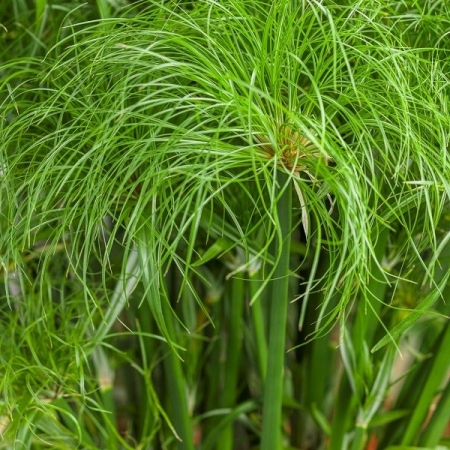Grass Cyperus papyrus (Egyptian Papyrus)
×
Color Name: Prince Tut
Graceful Grasses® Prince Tut is a compact form of Egyptian Papyrus that is half the size of 'King Tut.' This sturdy grass is versatile, working well in all container sizes with its columnar habit and dense canopy and filling out well in the landscape. Large heads of pendulous leaves; greenish flower spikelets can measure 1 inch across. Use as a centerpiece in large landscape beds or containers.
When planting in containers, hanging baskets and window boxes, we recommend using our potting soil which is specially formulated for our plants. An application of a time release fertilizer at the time of planting will help to ensure the best possible performance. Zehr's Osmocote blend is perfect for the job. We also suggest fertilizing every two weeks during the hot summer months of June, July and August with Maxsea, which you can purchase at Zehr's. Begonias, Impatiens and most plants grown for foliage normally do not need as much fertilizer.
Photo courtesy of Ball Horticultural Company.
Growing Tips: Graceful Grasses Prince Tut is a fast grower. The plant can be planted in pots, along the waters edge of a pond, or even in a pond. The crown of the plant should never be covered. In fact, it can thrive in water as shallow as a few inches. The purpose is to keep the bulk of the soil or root mass wet. If the plant is put into a pot, keep the soil moist. Prince Tut will also do well when planted in normal garden beds. It is best to keep the soil moist, but once established Prince Tut has proven to be surprisingly tolerant of dry conditions. In this area Prince Tut is considered an annual and will not winter over.
When planting in containers, hanging baskets and window boxes, we recommend using our potting soil which is specially formulated for our plants. An application of a time release fertilizer at the time of planting will help to ensure the best possible performance. Zehr's Osmocote blend is perfect for the job. We also suggest fertilizing every two weeks during the hot summer months of June, July and August with Maxsea, which you can purchase at Zehr's. Begonias, Impatiens and most plants grown for foliage normally do not need as much fertilizer.
Photo courtesy of Ball Horticultural Company.
Graceful Grasses® Prince Tut is a compact form of Egyptian Papyrus that is half the size of 'King Tut.' This sturdy grass is versatile, working well in all container sizes with its columnar habit and dense canopy and filling out well in the landscape. Large heads of pendulous leaves; greenish flower spikelets can measure 1 inch across. Use as a centerpiece in large landscape beds or containers.
When planting in containers, hanging baskets and window boxes, we recommend using our potting soil which is specially formulated for our plants. An application of a time release fertilizer at the time of planting will help to ensure the best possible performance. Zehr's Osmocote blend is perfect for the job. We also suggest fertilizing every two weeks during the hot summer months of June, July and August with Maxsea, which you can purchase at Zehr's. Begonias, Impatiens and most plants grown for foliage normally do not need as much fertilizer.
Photo courtesy of Ball Horticultural Company.
Growing Tips: Graceful Grasses Prince Tut is a fast grower. The plant can be planted in pots, along the waters edge of a pond, or even in a pond. The crown of the plant should never be covered. In fact, it can thrive in water as shallow as a few inches. The purpose is to keep the bulk of the soil or root mass wet. If the plant is put into a pot, keep the soil moist. Prince Tut will also do well when planted in normal garden beds. It is best to keep the soil moist, but once established Prince Tut has proven to be surprisingly tolerant of dry conditions. In this area Prince Tut is considered an annual and will not winter over.
When planting in containers, hanging baskets and window boxes, we recommend using our potting soil which is specially formulated for our plants. An application of a time release fertilizer at the time of planting will help to ensure the best possible performance. Zehr's Osmocote blend is perfect for the job. We also suggest fertilizing every two weeks during the hot summer months of June, July and August with Maxsea, which you can purchase at Zehr's. Begonias, Impatiens and most plants grown for foliage normally do not need as much fertilizer.
Photo courtesy of Ball Horticultural Company.
|
Flower Color: Grown For Foliage Foliage Color: Green Shades
Height: 18 to 30 Inches Spread: 24 to 36 Inches Hardy in Zone: 10 |
Blooms:
Foliage Season: All Season |
Growth Rate |
Medium
|
Attributes |
Container Specimen Plant Mass Planting Easy to Grow Landscapes Cut Flower or Foilage Water's Edge
|






